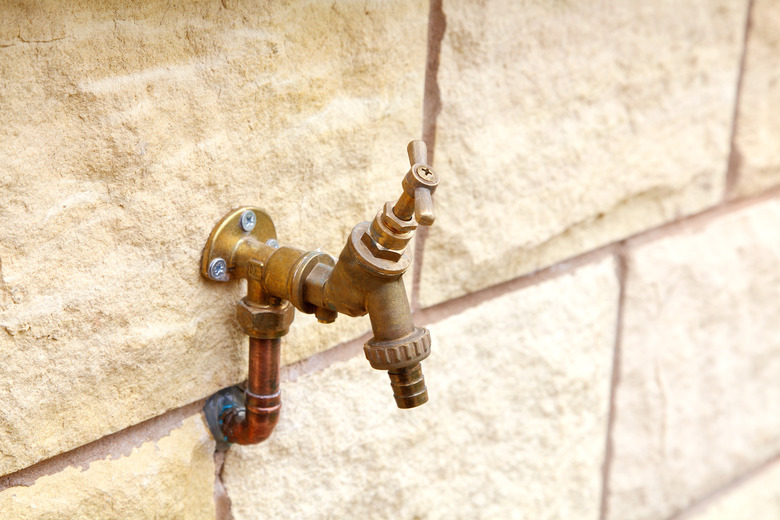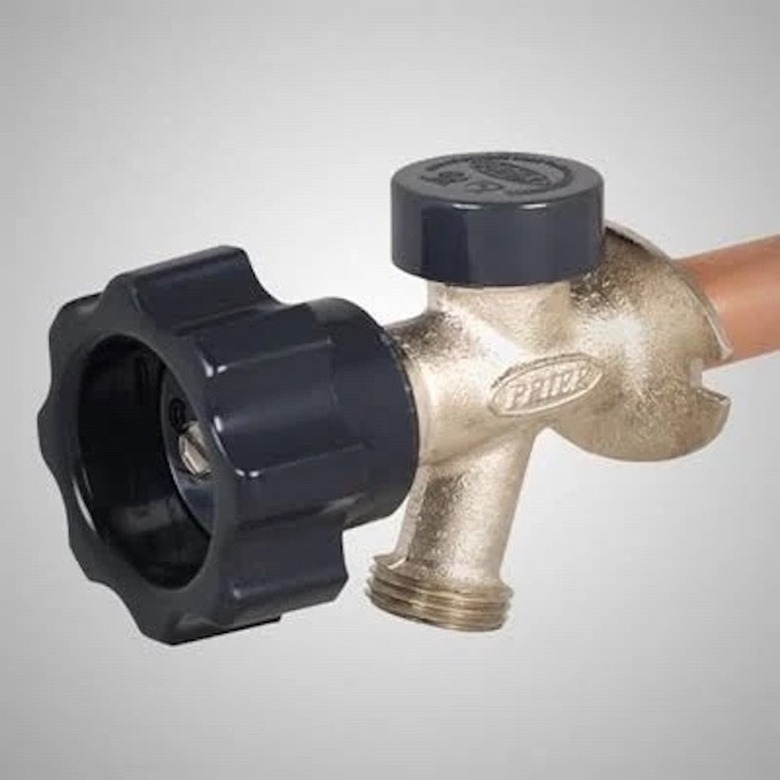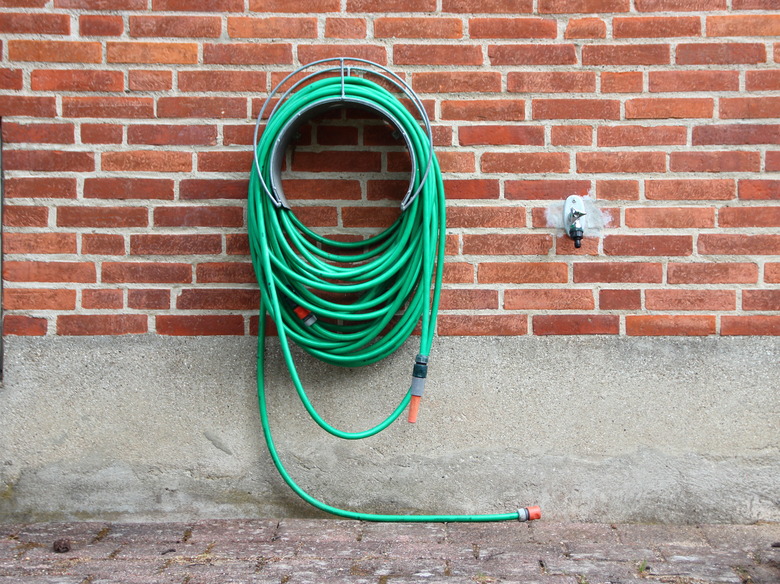How Does A Freezeproof Outdoor Faucet Work?
We may receive a commission on purchases made from links.
A freezeproof outdoor faucet is the perfect upgrade for an older home in any climate with cold winters. As the name indicates, a freezeproof or frostproof faucet doesn't freeze even in subzero weather, effectively preventing a burst pipe behind the faucet. Having a frost-free faucet also means you won't have to shut off the water indoors on the pipe leading to the faucet when the weather gets cold, but you should still disconnect a hose attached to it to prevent freezing.
Whether you hire a plumber or DIY the installation of a freezeproof outdoor faucet — here's everything you need to know about how it works and which model to choose.
Tip
A freezeproof outdoor faucet is a faucet that doesn't freeze even in subzero weather.
Freezeproof Faucet or Hose Bib?
Freezeproof Faucet or Hose Bib?
A freezeproof faucet and a freezeproof hose bib are essentially the same thing: an outdoor spigot that makes it more convenient to water plants or wash the car. Specifically, a hose bib is threaded on the end to accept a garden hose, while not all outdoor spigots or faucets are. If you're planning to swap your current outdoor spigot for a freezeproof model, a freezeproof hose bib is the best option since it's more useful than a spigot that isn't threaded for a hose. In most cases, the frost-free faucets you'll find in home centers and online are hose bibs.
Don't be confused by the many names of frost-free faucets when you're shopping. Products labeled as sill cocks, sillcocks, outdoor taps, hose bibs, hose valves, and even hydrants that are sold in the frost-free plumbing section are all the same thing. The key is to make sure the product says "freezeproof" or "frostproof" somewhere on the labeling.
Freezeproof vs. Standard Faucet
Freezeproof vs. Standard Faucet
At its simplest, the difference between a freezeproof faucet and a standard faucet is that the freezeproof variety doesn't always require indoor shutoff in cold-winter climates because there's far less chance of the device freezing due to water in the pipe. However, with improper installation or with a hose attached, it's still possible for a freezeproof faucet to freeze.
A standard hose bib or outdoor faucet stops the water flow directly at the faucet so the water in the pipe is in contact with outdoor temperatures and can freeze during cold weather. Water expands when it freezes, which could burst the metal faucet or the pipe directly behind it. Besides having to replace the faucet and the damaged pipe, this may result in the far worse problem of flooding in your home or outdoor area.
A freezeproof faucet includes a section of pipe (often 8 inches or longer) attached to the back of the faucet body. Inside the pipe is a rod with a washer at the rear (indoor) end that controls the flow of water into the pipe and ultimately out through the faucet spout. When you shut off the faucet, any water remaining in the pipe automatically drains out through the spout; the pipe is tilted slightly downward to the outside. This means no water is left inside the pipe to freeze.
The pipe is long, so it extends into the house where the temperature stays above freezing. There's no danger of a burst pipe or faucet since the pipe isn't cold enough to freeze. Furthermore, there's no lingering water in the portion of pipe nearest the outdoor faucet, so there's no chance of any sizable amount of water turning to ice and expanding in or near the actual faucet.
Choosing a Freezeproof Faucet
Choosing a Freezeproof Faucet
Frost-free faucets come in lengths ranging from 4 to 24 inches, and the length that's best for your house depends on the thickness of the wall and how much frost protection you need; it must extend into a reliably warm area of the interior space. If you already have a frost-free faucet and simply want to replace it, you can purchase a new one of the same length.
Another consideration is the connection to the water supply pipe or shutoff valve. If the new faucet allows you to connect to the pipe or valve without making changes, great. If not, you can simply extend the supply pipe as needed to work with one of the standard freezeproof faucet lengths. Make sure the connection is in an accessible location for easy installation and for future inspection.
Look for a frost-free faucet with an anti-siphon feature, which is a common code requirement. Most frost-free faucets available have anti-siphon features built in, but to be sure when you're shopping, look for such wording somewhere on the manufacturer's information for the product. Anti-siphon units have a built-in vacuum breaker, which simply means that water from an attached hose, for instance, can't travel back into the water pipes in your house if the household water pressure suddenly drops. This feature is especially important when you've attached some type of chemical sprayer to the hose, as no matter what's in the sprayer, you surely don't want it getting into your household water supply. Plumbing codes typically require anti-siphon valves on new outdoor faucets, so there's no reason not to get one.
Freezeproof Faucet Connections
Freezeproof Faucet Connections
Freezeproof faucets are available with different connector types, including soldered and threaded connections for copper pipe, PEX connections for PEX pipe, and threaded connections for galvanized steel pipe. There are also adapters for connecting to PVC or CPVC pipe. For DIYers with limited plumbing skills, the easiest option is to use a faucet with a push-in connector, such as with a SharkBite faucet. Push-in connectors work with copper, PVC/CPVC, and PEX pipe. If you have galvanized pipe, you can add a transition fitting and switch to copper or PEX before making the connection to the faucet's push-in fitting.
Replacing an Old Hose Bib With a Freezeproof Faucet
Replacing an Old Hose Bib With a Freezeproof Faucet
The specific steps for removing an old hose bib and installing a new freezeproof faucet vary from one house to the next, but the basic process is the same for most situations. Old-style hose bibs that aren't freezeproof often have a shutoff valve on the supply pipe to the faucet. This is located inside the house and typically includes a bleed valve so you can shut off the water to the faucet in the winter and drain the final section of pipe from the faucet and the bleed valve (if present) to prevent freezing. A freezeproof faucet performs this function itself, but it's still a good idea to include a shutoff valve inside the house in case there are problems with the faucet down the road (outdoor faucets see a lot of hard use). This shutoff valve is also commonly required by plumbing codes.
To replace an old hose bib, complete the following:
- Shut off the water supply to the faucet pipe using a nearby shutoff valve or the home's main supply shutoff and then open the hose bib to relieve pressure and drain the pipe.
- Remove the old hose bib either by unthreading it from the pipe or by cutting off the pipe inside the house.
- Test-fit the freezeproof faucet and make sure it has the proper downward slope per the manufacturer's specifications.
- Install a new ball-type shutoff valve onto the pipe and if necessary, a length of new pipe to reach the faucet connection.
- Apply caulk to the back side of the faucet to make a watertight seal with the wall.
- Slip the faucet into place and connect it to the valve or pipe extension.
- Secure the faucet to the wall with screws.
- Turn on the water and test the faucet, letting the water flow and then turning it off and making sure it drains properly.
References
- Woodford Manufacturing Company: How a Standard Frost-Proof Faucet Works
- Tony La Martina Plumbing Company: Do I Need a Frost Free Hose Bib?
- SharkBite: How To: Install SharkBite Outdoor Hose Bib Or Sillcock
- Family Handyman: How to Install a Frost-Proof Outdoor Faucet
- South End Plumbing: Winterizing Outdoor Faucets


